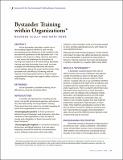| dc.contributor.author | Scully, Maureen | |
| dc.contributor.author | Rowe, Mary | |
| dc.date.accessioned | 2024-09-03T20:58:20Z | |
| dc.date.available | 2024-09-03T20:58:20Z | |
| dc.date.issued | 2009 | |
| dc.identifier.uri | https://hdl.handle.net/1721.1/156545 | |
| dc.description.abstract | Active bystanders may play a useful role in discouraging negative behaviors, and, we add, encouraging positive behaviors in the workplace. We describe the significance of the bystander role—for example, with respect to safety, diversity, and ethics—and review the challenges for bystanders in moving from a passive to an active stance. Bystander
training may help bystanders learn small, concrete strategies for intervening effectively. We review current debates about the power and the limits of the bystander role, the efficacy of training, and the capacity of local bystander action to foster broader organizational changes that support safety, inclusion, and integrity. | en_US |
| dc.language.iso | en_US | en_US |
| dc.publisher | Journal of the International Ombudsman Association | en_US |
| dc.subject | bystanders, active bystanders, bystander training, microaffirmations, diversity, bystander effect | en_US |
| dc.title | Bystander Training within Organizations | en_US |
| dc.type | Article | en_US |
| dc.identifier.citation | Maureen Scully and Mary Rowe, “Bystander Training within Organizations,” Journal of the International Ombudsman Association Vol. 2, No 1. (Winter 2009): 89-94. | en_US |
